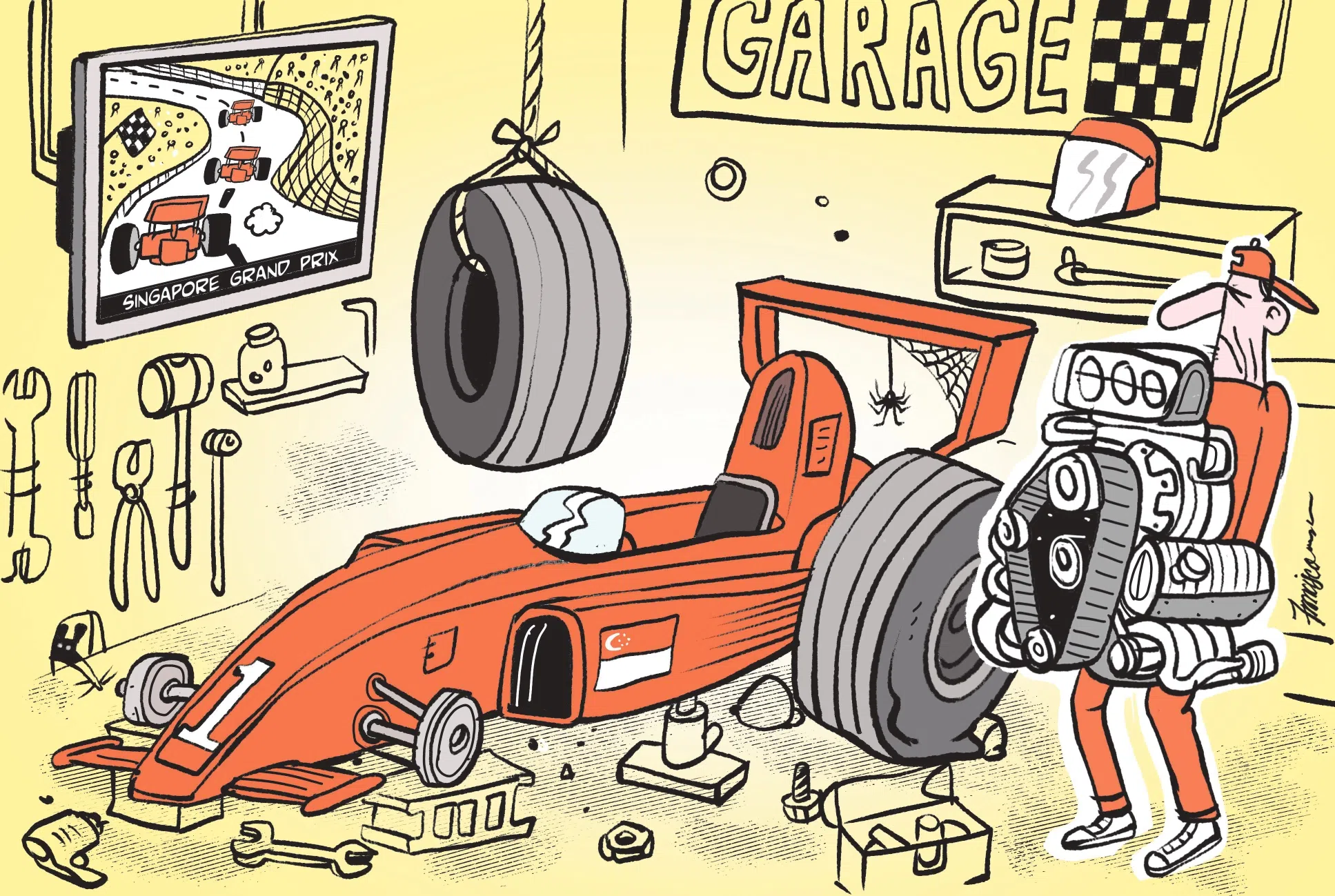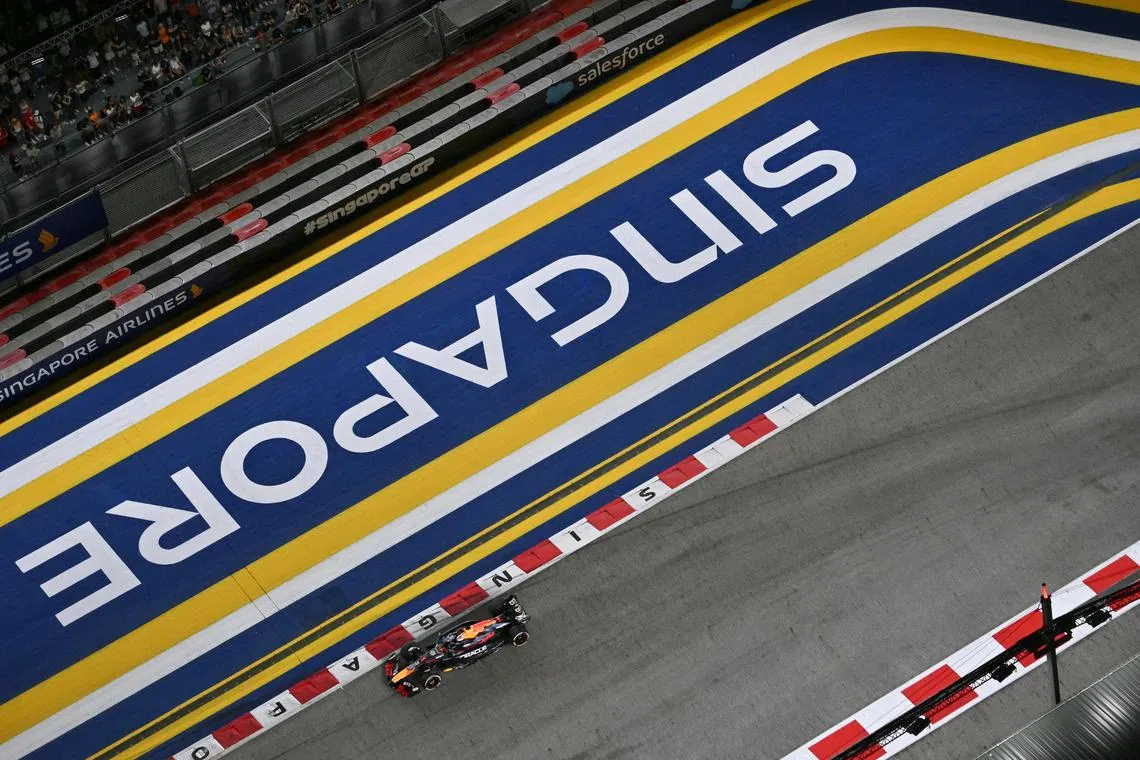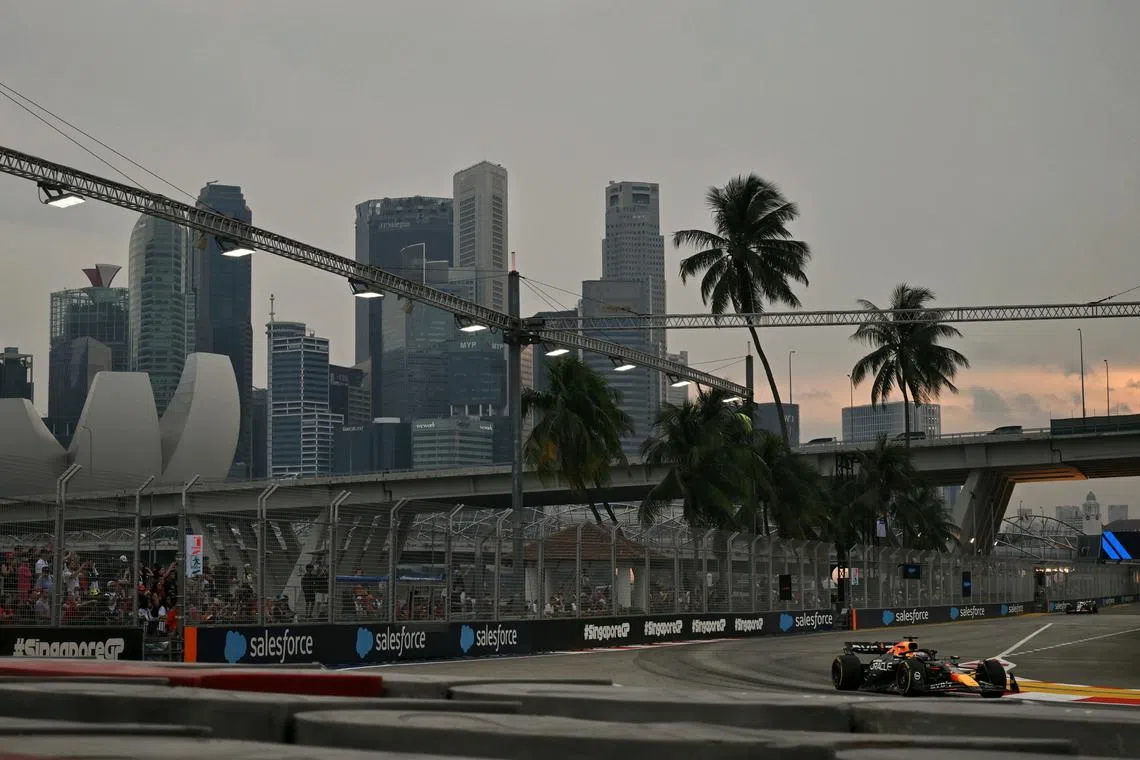Singapore Grand Prix a ‘tourist attraction’, few benefits for motor racing scene, says community
Sign up now: Get ST's newsletters delivered to your inbox
![[NOTE: F1 photos are for editorial use only and NOT for sale.]
Practice 2 of the Formula One, on Sept 20, 2024.](https://cassette.sphdigital.com.sg/image/straitstimes/f0be0099d17c750459cccd3290c7c60d013839892f8469e7c0702890ff332e3a)
Despite the billions of dollars poured into the race, S'pore’s motor sport ambitions have hit many speed bumps.
ST PHOTO: ARIFFIN JAMAR
Follow topic:
SINGAPORE – It has been dubbed Formula One’s crown jewel and for close to 15 seasons, the Singapore Airlines Singapore Grand Prix has delivered a glitzy, glamorous spectacle for global and local audiences.
Cash tills have been ringing since the first night race in 2008, boosting Singapore’s economy by generating around $2 billion in incremental tourism receipts and grabbing eyeballs – over one billion viewers globally.
But once the chequered flag is waved, the confetti swept away and the garages emptied, Singapore’s motor sports scene falls into an uneasy silence.
Despite the grand prix’s economic and tourism impact, Singapore drivers, officials and observers say it has not been the catalyst for growth that the community had hoped for when the race first roared into town.
While former Super GT race driver Melvin Choo feels that it has generated more interest in motor sports, he also noted that the event is “a tourist attraction”.
Choo, 54, said: “If you think about it carefully, it does not in any way really support any grassroots racing, it doesn’t involve any grassroots racing.
“When people think of Formula One and people who are actually on the ground doing racing, there’s a disconnect, there’s nothing funnelling down to them.”
Despite the billions of dollars poured into the race, Singapore’s motor racing ambitions have hit speed bumps due to a number of factors cited by the fraternity – the lack of infrastructure, a limited pool of young drivers and the lack of a motor sports culture and sponsors.
Motor sports hub dream over
Where once there was karting, rallying and other races at the old National Stadium carpark in Kallang, now the options are increasingly limited, say the community, who pointed to a lack of infrastructure with projects falling by the wayside and other venues shutting down or at risk.
The Changi Motorsports Hub, once envisioned as a cornerstone for a thriving motor sports culture, was mooted over a decade ago to be the nation’s top venue for all major races except for F1.
The $380 million project was awarded to the SG Changi consortium in 2010, but it ran into delays and financial trouble amid allegations of corruption. The Singapore Sports Council (SSC), now known as Sport Singapore (SportSG), eventually pulled the plug in 2013.
Instead, the 41ha site will be converted into an industrial site to support the construction of Changi Airport Terminal 5
Go-karting tracks have come and gone – the Karting Arena in Bukit Timah closed in 2022 while its Jurong premises shut down in March. Facilities at Marina Bay and Singapore Expo carpark operated by KF1 Karting have also closed within the last nine months.
There is now a cloud over the future of the country’s last remaining permanent karting facility, the KF1 track at the Singapore Turf Club, with the Kranji space set to close by March 2027 to make way for housing and other developments.
Richard Tan, managing director of Arina International Holdings, the construction company which built and operates the venue, said it hopes to remain at the premises “for as long as we can” though it is searching for another location for a new track.
He added: “We are located at the corner of Turf Club and I think development work here will only begin much later, so we are hoping to get some good news that we can stay a little longer than March 2027.”

ST ILLUSTRATION: MANNY FRANCISCO
With no proper facility, it is hard to cultivate a motor sports culture here, said Motor Sports Singapore (MSS) general-secretary Henry Goh.
He said: “For motor sports to thrive, we need a spectator group that knows where to go. We need to identify locations accessible to the public. Without a physical space, it is hard to thrive.”
Veteran race driver Ringo Chong stressed the importance of having a “top-tier karting track and facilities” for young drivers to start their motor sports journey.
Chong, a three-time winner at the Singapore Grand Prix’s support races, said: “Currently, there’s a lack of high-quality karting tracks with longer layouts, wider tracks, and high-speed corners – features that are essential for hosting international karting events, including the world championship.
“Building such a facility would not only attract global competitions, but also raise the standards of driving locally.”
The Changi Motorsports Hub could have been a game-changer, said former professional racing driver Andrew Tang.
The 29-year-old said: “It would’ve made a big difference, it would’ve attracted more talent to come here, opened up the opportunity for more races to come here, and that would’ve helped us become better drivers, and then it’s a bit of a snowball effect.”
Space is a premium in land-scarce Singapore, but Oon Jin Teik, former chief executive of the Singapore Sports Hub and SSC, believes that is not the main reason why plans for a motor sports hub have not been revisited.
The challenge in getting such a facility up and running lies in it being a “complex multi-agency task that SportSG cannot manage alone”.
He stressed that a hub would require “many hands to pull it together” and that it should not just be about racing, but it should have “a real business ecosystem” that would create jobs.
He also noted that this was the vision for the Changi Motorsports Hub, with the SSC and the Singapore Economic Development Board collaborating on the project.
For Singapore to revisit this plan, there needs to be someone who understands the value of industry development who drives it and is supported by leadership, said Oon.
The former national swimmer added: “Given Singapore’s F1 track record, it would be a waste not to leverage on this mega event for motor sports ambitions.
“The F1 property is a powerful draw, but it needs to be used strategically to develop local motor sports talent and infrastructure.
“Without proper utilisation, it’s a missed opportunity to capitalise on a unique asset.”

Dutch driver Max Verstappen of Red Bull Racing during Practice 2 of the Formula One Singapore Airlines Singapore Grand Prix on Sept 20.
ST PHOTO: ARIFFIN JAMAR
Lack of local racing talents
There have been some exciting developments for Singapore motor sports recently, with Christian Ho, 17, set to become the country’s first driver to compete in the FIA Formula 3 Championship
In April, Kabir Anurag became the first Singaporean to be recruited by Alpine F1 Team’s driver development programme
Rishab Jain, meanwhile, competed in the Italian Formula Four Championship in 2022 and is now racing in the Regional F3.
But they are among the minority. It remains a niche sport, with Tang noting that the number of drivers actively pursuing a racing career has not changed much from when he was chasing his F1 dream.
That is down to a variety of reasons, from the lack of facilities to high barriers of entry such as cost.
Then, there is also national service, which Tang said has hindered the progress of many up-and-coming drivers.
He said: “When you stop, everyone is still honing their craft and getting better. So when you come back after the two years, even though it doesn’t sound like much but it’s exponential when you consider you’ve stopped and everyone else is still going.
“Ultimately it’s not just one factor, it’s a bunch of different factors that make it such that it’s not progressed as easily as we had hoped, but steps are still being taken with F1.
“It’s good that it’s garnering more interest worldwide, but it may take a bit more time (here).”
Culture shift needed
Although the Singapore Grand Prix has generated interest in F1, retired race driver Yuey Tan believes the grassroots scene for developing drivers today is weaker than it was in 2008, when the marquee event was first held.
The 42-year-old, who competed in the support races at 13 editions of the grand prix, believes that things have improved for mass market education, but still feels that there is a lack of understanding of what it takes to become a racing driver, which entails not just competing but also the commercial aspects.
That has been made difficult with limited media exposure beyond F1 and the challenge of professionalising sport in Singapore.
Tan said: “It hasn’t really trickled down to the young and there’s a whole system that hasn’t been put in place in the last 15 years to be able to do that.
“So infrastructure, exposure, commercialism, training a junior sports person, it’s just about the whole ecosystem that could use some work.”

Despite the grand prix’s economic and tourism impact, Singapore drivers, officials and observers say it has not been the catalyst for growth that the community had hoped for when the race first roared into town.
ST PHOTO: ARIFFIN JAMAR
Having a leading driver could be a catalyst for change, said Lee Lung Nien, vice-president (Asia Pacific) of the International Automobile Federation (FIA).
“You must have a successful individual. Then parents want their kid to be the next star. You saw that in swimming with Joseph Schooling and now kitefoiling after Max (Maeder). Football had Fandi (Ahmad),” said Lee, who was MSS’ president from 2016 to 2020.
“You need a local star. Then perhaps the demand is there for us to have the infrastructure in Singapore.”
There have been some breakthroughs from Singaporeans on the international racing stage, such as Christian, Kabir and Rishab.
With young Singaporeans making their mark overseas, MSS’ Goh hopes to capitalise on that momentum to “benefit the community here”.
Not all hope is lost
There are speed bumps aplenty in Singapore’s quest to grow the sport, but those in the industry remain hopeful.
Several observers have identified e-sports as an area that the Republic could tap into to help develop talents in land- and facility-scarce Singapore.
Goh noted that there was a “big spike” in e-sports during the Covid-19 pandemic, with many young people taking up simulated racing.
Referencing the movie Gran Turismo, a film depicting the real-life story of British teenager Jann Mardenborough’s journey from gamer to professional race driver, he said: “In the world of FIA and motorsport, there are pathways for someone very good at e-sport, to channel themselves and then to move up the rung into hopefully realising their dreams of going to the Formula series of motor racing, or motor racing per se.”
Simulation racing is gaining traction globally, with a report by market analysis company Market Research Future stating that the market size was worth US$510 million (S$658 million) in 2023 and is expected to grow to US$1.68 billion by 2032.
Choo said: “There is hope if we think out of the box, look forward and understand where the trends are, rather than go down the alley and that has been proven to be very difficult.”
Lee estimates that about 2,000 people are involved in the “thriving” e-sports racing scene here. Though Goh noted that ultimately this will circle back to the need for a track, adding: “Our internet infrastructure (for e-sports) is strong but then for the next step (in development) everything goes south without a track.”
In response to queries from The Sunday Times, a SportSG spokesman said that it works with MSS to promote motor sports through initiatives such as providing dollar-for-dollar matching for donations through the One Team Singapore Fund, as well as funding support under the Athletes’ Inspire Fund.
Noting that motor racing is a land- and resource-intensive sport, the spokesman said: “While the Government recognises the growing popularity of motor sports and the potential shown by some of our local athletes, we must carefully balance the allocation of resources with other national priorities and sporting needs.
“SportSG is working with the relevant agencies to identify a suitable site for sport use which can include motor sports and will provide updates when plans are firmed up.”
And as the Singapore Grand Prix flags off at the Marina Bay on Sept 22, and with another four years remaining on the contract, Oon emphasised that it is crucial to consider the event’s legacy “after the circus leaves town”.
He said: “After the F1 contract ends, what do we have left? Just memories? I think that question needs to be asked.
“We need to address the legacy of the Singapore F1 (and other mega events hosted in Singapore) and to start focusing on building and investing in an ecosystem that will have regional impact.”

